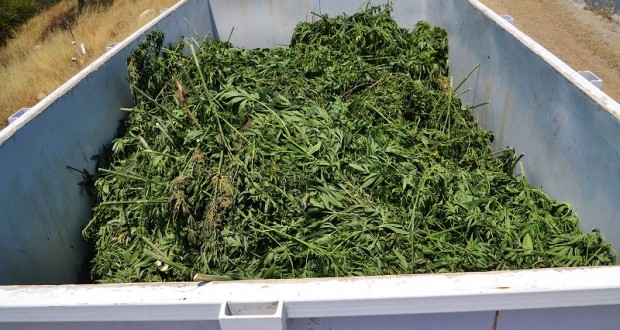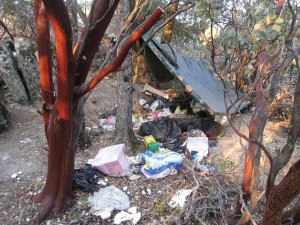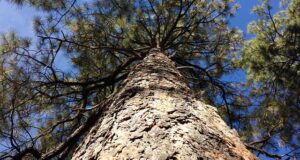OAKHURST — Law enforcement officers were busy today in the Miami and Lewis Creek areas north of Oakhurst, eradicating several large marijuana grows from public lands.
Members of CAMP (Campaign Against Marijuana Planting) worked in short-haul teams out of the Batterson Work Station heliport, removing plants and the accompanying infrastructure from illegal grows on the Sierra National Forest.
 A short-haul operation involves lifting pairs of officers on a long line below the helicopter and inserting them in teams at strategic locations around each grove.
A short-haul operation involves lifting pairs of officers on a long line below the helicopter and inserting them in teams at strategic locations around each grove.
The Madera County Sheriff’s Office Narcotics Detective (who will not be identified here) running the operation says these illegal grows not only destroy public lands, they also bring crime and violence.
“Cartels become involved,” says the detective. “Marijuana is a very lucrative business, and it’s not about the plant, it’s about the money. This is another way for them to facilitate and fund their operations, and we are not exempt here in our county from the violence, shootings and murder that come with these operations.”
While the targets of today’s eradication operation were on public lands, the detective says the same problems arise with grows on private land.
“Just because you’re growing on private land doesn’t mean it’s legal,” he says. “When you’ve got a big grow that others can see and people become aware of it, you’re going to attract the same type of violence.”
That was evidenced on Aug. 7, when an Oakhurst man was shot and killed in what law enforcement says was a dispute over a marijuana grow on private property.
When Proposition 64 was passed by California voters in November 2016, it made the recreational use of marijuana legal for those over the age of 21, and allows individuals to grow up to six plants within a private home as long as the area is locked and not visible from a public place.
Each county throughout the state has its own ordinances governing the growing of marijuana, and it’s up to the individual to know what’s legal and what isn’t.
“By regulating and patrolling and forcing private grows indoors, we can bring a bit more safety — out of sight, out of mind,” says the detective, who notes that current Madera County law restricts grows to one room inside a single family dwelling that doesn’t exceed 120 sq. ft., or one detached, outdoor, enclosed structure where the cultivation is concealed from view, also 10 x 12′ or less.
Another danger posed by large, indoor grows is the diversion of electrical power which is often badly rigged and can spark fires.
 Today’s operation inserted teams into outdoor grows on public lands, where the first order of business was to clear the scene of any safety issues such as booby traps, and look for any people who may be present. Officers then document the scene, taking photos, noting the number of plants, any make-shift habitations, watering systems, pesticides, and the ever-present trash, seemingly indigenous at these types of illegal operations.
Today’s operation inserted teams into outdoor grows on public lands, where the first order of business was to clear the scene of any safety issues such as booby traps, and look for any people who may be present. Officers then document the scene, taking photos, noting the number of plants, any make-shift habitations, watering systems, pesticides, and the ever-present trash, seemingly indigenous at these types of illegal operations.
Marijuana grows on the national forests have become a danger to both the public and the wildlife who inhabit the area. The pesticides, herbicides and fertilizers used in these large-scale operations poison wildlife and fisheries, and cause untold environment damage — and the public pays. It requires vast amounts of money and time to locate and destroy these grows, then rehab and restore the sites.
They also pose a significant danger to the officers on the ground, says the detective.
“Some of these grows are so toxic that personnel have had to evacuate due to the hazardous material,” he says. “Some of these pesticides and herbicides are liquid and some are powder that is activated by stepping on it. We’ve had to change some of our methods and tools and always be conscious of our personal protection equipment.”
On recent operations, he says, they have had a doctor — who is a leading author in this field — doing a study for the California Department of Justice to establish safety protocol for personnel working eradication operations.
After the plants themselves have been removed, the work of rehabilitation begins.
“We will remove miles and miles of drip lines, and repair the ponding basins that have been dug out to collect water,” says the detective.”They are polluting the land and the water sheds with dangerous, often illegal chemicals.”
These grow sites also contain such things as propane tanks and portable cook stoves, plus tents, large amounts of trash, and other things used by those who camp there — often heavily armed — to protect their crop.
California is one of the largest suppliers of marijuana, says the detective, and with the advent of new growing procedures including greenhouses, what used to be a seasonal job is now year-round.
CAMP has four regional teams across the state, and in his 10 years of doing this work, the detective says he has participated in eradicating over one million illegal plants.
The Team is made up of law enforcement officers from the Sheriff’s Office, the U.S. Forest Service, the California Dept. of Fish and Wildlife and the National Guard.
Madera County Sheriff’s Commander Tyson Pogue says these eradication efforts are not about whether people should be allowed to grow marijuana.
“These operations shouldn’t be viewed as much about whether or not marijuana should be legal or illegal, but more about the destruction and dangers these criminals are bringing to our public lands,” says Pogue.
“They leave a wake of destruction and pose a great risk to innocent hikers, hunters and families trying to enjoy the forest. They have no right to destroy the public land in the manner they do and it’s not fair to the families and people who may stumble into these areas by accident.”
These grows were made known to law enforcement through various ways, including overflights, reports from hikers or hunters about suspicious people or activity, or even something as simple as downslope evening breezes carrying the pungent aroma.
The people tending these grows have to be resupplied on a regular basis, so residents keeping an eye out for people who don’t belong, or loads of groceries and gardening equipment being hauled into the woods, can aid law enforcement in removing these dangers operations.
Some things to watch for when recreating on public lands:
- Cleared brush and timber in remote areas
- Signs of cultivation or soil disturbance in unlikely or remote areas
- Unusual structures in remote areas such as lean-tos or tents made from cut trees, brush, or tarps
- Large quantities of food and cooking supplies, sleeping bags, clothing, etc., indicating live-in camps
- Buckets, garden tools, various size plant pots, pesticides, fertilizer, and propane tanks
- Plastic PVC hoses, pipe, and sprinkler fittings coming from streams and makeshift water reservoirs
- Camouflage clothing or netting
- Marijuana plants (five-lobed, green leaves with serrated edges, height varies)
- Many different types of water reservoirs are built to provide water to marijuana plants. Trough-like structures, culverts covered by tarps, and PVC hoses and pipes coming from streams are common.
If you come upon something you think is a marijuana grow, you should leave immediately. Make note of any landmarks, vehicles or people in the area, and if you have a phone, mark the GPS location to help law enforcement locate the site.
Growers are often armed with all types of weapons, including assault rifles and booby traps, and a remote marijuana grow is not a place you want to hang around for very long.
For the stark and shocking reality of what illegal marijuana grows are doing to our public lands, watch the video below, produced by the USDA Forest Service.





